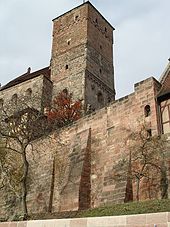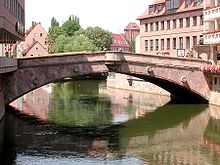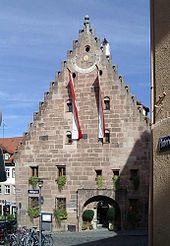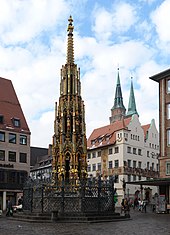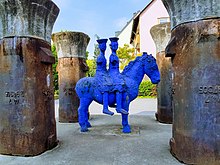Art and architectural monuments of the city of Nuremberg
Ludwig Tieck and Wilhelm Heinrich Wackenroder rediscovered the importance of Nuremberg in terms of culture and art history at the end of the 18th century (see Early Romanticism ). The old town, which was largely destroyed in the Second World War, was partially restored in its historical form in the decades after 1945. In the list of architectural monuments in Nuremberg , all of the city's monuments are listed individually.
Museums
Germanic National Museum
The Germanisches Nationalmuseum (GNM) extends along the southern city wall over several building complexes and shows examples of objects relating to German art and culture from prehistory to the present day. There are constantly changing special exhibitions.
Other museums
- Museum of industrial culture
- Neues Museum (State Museum of Art and Design) with sculpture garden
- Museum Tucherschloss with the Hirsvogel Hall, which has been rebuilt there
- Toy Museum Nuremberg
- Stadtmuseum Fembohaus (includes the great peace meal (1650) by Joachim von Sandrart )
- Transport Museum (DB Museum and Museum for Communication)
Churches and monasteries
- Inside the city walls:
- St. Lorenz is a magnificent Gothic church building and, in terms of urban planning, forms the counterpart to St. Sebald. The building, which was badly damaged in World War II , was rebuilt in its old form. The church contains an extremely rich medieval interior, which was largely brought together from secularized monasteries.
- St. Sebald : nave, tower basement and west choir belong to the latest Romanesque, the mighty east choir comes from the Parlerzeit . The building was first historically renewed, then heavily damaged in the Second World War, then rebuilt and restored several times since then. There are also many important art treasures to be seen here.
- The Frauenkirche was built by Emperor Charles IV on the main market, where the synagogue, which had been demolished with his approval, had previously been. The building was erected over 3 × 3 yokes as a hall church with choir and richly carved vestibule at about the same time as the east choir of St. Sebald. The famous Männleinlaufen is on its west facade .
- St. Egidien stands below the castle and is a baroque building, but it was badly damaged in the Second World War. A two-aisled crypt from the Romanesque era has been preserved from the former Schottenkloster.
- St. Elisabeth by Wilhelm Ferdinand Lipper is a classicist building with a dome, the pillars of which are encased in stucco marble.
- The Heilig-Geist-Spital was a charitable foundation of Konrad Groß, the richest Nuremberg resident of the first half of the 14th century. Imperial regalia have been kept in the Holy Spirit Church, which was destroyed during World War II, since Emperor Sigismund.
- St. Jakob , a basically medieval church west of the White Tower. Since the church belonged to the Teutonic Order during the entire imperial city period, it always remained Catholic.
- Carthusian monastery , former monastery, part of the Germanic National Museum since 1857
- St. Katharinen (profaned), from Gothic times.
- St. Klara stands directly on the city wall (approximately at the level of the train station) and shows a close relationship with St. Sebald in the decorative shapes of the 13th century, today known as the meditation church Open Church of St. Klara
- St. Martha in Königstrasse opposite the Klarakirche, magnificent Gothic stained glass.
- Moritzkapelle, stood next to the Sebalduskirche, was destroyed in the war.
- Outside the city walls:
- St. John's Church from the 13th century; the graves of Albrecht Dürer , Willibald Pirckheimer , Veit Stoss and other famous people from Nuremberg are in the cemetery
- Rochus Chapel
- Reformation Memorial Church near the city park
Profane architectural monuments
Imperial Castle
The Nuremberg Castle , rebuilt after 1945 , now houses u. a. a branch of the Germanisches Nationalmuseum (weapons department, history of the castle) and is the landmark of the city. The castle complex, one of the most important fortifications in Europe, includes the actual imperial castle with the Romanesque double chapel , the Sinwell tower and z. Some of the late medieval halls, the Burggrafenburg to the east and the imperial stables of Hans Beheim the Elder with the pentagonal tower and the Luginsland located to the northeast .
town hall
The town hall is just east of the choir of St. Sebald. From the west, the town hall is still recognizable as an imposing baroque building by the architect Jakob Wolff the Younger , even if it had to be rebuilt for the most part after 1945 (it was shortened by two window axes on the north side). A hall, which is Gothic in the core, is integrated on the south side. The pothole prisons are a tourist attraction.
The main market should be emphasized as an urban ensemble, the Frauenkirche and the Schöne Brunnen ( reconstruction from the early 20th century; some of the original parts are displayed in the Germanic National Museum).
City fortifications
The outer wall, even if it has been heavily restored or rebuilt in parts, is almost completely preserved; of the inner wall, which was probably started in the middle of the 13th century, the White Tower in the west, the Laufer Schlagturm and the debt tower on the island of Schütt are prominent points.
At the western exit of the city, the so-called Fronveste from 1489/94 imposingly spans the Pegnitz ; the Schlayerturm with its eight-sided helmet adjoins to the north.
Behind, on and in front of the wall and in the partially preserved ditch there are mostly publicly accessible walking paths. In the mighty castle bastions to the west and north of the castle, the castle garden was created, which is generally accessible in the warm season.
bridges
Several historical bridges span the Pegnitz, which is multi-armed by islands, within the city wall.
- The southern Charles Bridge (named after Emperor Karl VI. ) From 1728. Two baroque obelisks show the war eagle and the dove of peace in juxtaposition . The Northern Charles Bridge ( also called the Derrer Bridge after a Nuremberg patrician family ) was built as early as 1486 and its core is still preserved in its old state.
- The museum bridge at the beginning of Königstraße, named after the adjacent house of the “Museum” society. A wooden bridge stood here until 1484, after the Franciscan or Barefoot Monastery, also known as the Barefoot Bridge, which existed on the north bank into the 16th century . In 1700 a new stone building was built in its place. It was rebuilt in 1954 in a widened form and based on the previous shape. Of the old one, only the two baroque structures of the imperial monuments for Leopold I and Joseph I have survived.
- The Fleischbrücke spans the Pegnitz in a single arch. It was constructed from 1596–1598 based on the model of the Ponte Rialto in Venice by master Peter Karl and built under the direction of council builder Wolf Jacob Stromer . A model of the Rialto Bridge is in Grünsberg Castle .
Since February 9, 1599, a stone ox has been lying on the portal at the meat bridge, which once led to the meat shop. Its Latin inscription reads “Omnia habent ortus suaque in crementa sed ecce quem cernis nunquam bos fuit hic Vitulus.” (Translated “All things have a beginning and a growth, but see: the ox you see here has never been a calf . "). The ox with its inscription has been the cause of a lot of mockery and subtlety over the centuries and “The ox on the meat bridge could have told me that too” is still often a response to a senseless answer in Nuremberg today. - The Maxbrücke , built in 1457 and completely renewed in 1852/53.
- The Kettensteg at the old town outlet of the Pegnitz. Constructed in 1824 by the mechanic Conrad Georg Kuppler , it was the first free-floating suspension bridge in Germany. The name comes from several three-meter-long links on which the bridge is suspended and which are anchored to six pylons and massive abutments on both sides of the river. Since the construction was not considered stable enough, iron girders were added to the sides in 1930 and supported with wooden pillars.
theatre
- The opera house is an imposing building from the Wilhelminian era ; it is located at the train station, just outside the city wall (today the State Theater Nuremberg , the theater and the Kammerspiele).
Other profane structures
- The Nassauer Haus is the only surviving residential tower from the Middle Ages in Nuremberg, directly opposite the Lorenz Church . With its corner core it radiated architecturally far into the Nuremberg Renaissance period.
- The Fembohaus is the only surviving town house from the Renaissance period in Nuremberg. Several state rooms have been preserved inside, and magnificent wall cladding from the Pellerhaus , which was destroyed in World War II , found a new home here. Today the Fembohaus contains the Nuremberg City Museum.
- The former Unschlitthaus was built in 1490/91 from sandstone blocks by Hans Beheim the Elder; with the west side it stands directly on the Pegnitz. A stepped gable characterizes the south side.
- Rock passages in the underground of the castle hill
Parks and park-like facilities
- Castle garden on the former bastions, north and west of the castle.
- Parts of the former city fortifications are designed like a park.
- Hallerwiese , west of the Hallertors on the Pegnitz to the Kleinweidenmühle.
- Rosenaupark
- Hesperidengärten , in the suburb of St. Johannis (Johannisstrasse, south side)
- The Johannisfriedhof in St. Johannis (crossing Brückenstrasse / Kirchenweg) was laid out as a plague cemetery outside the city walls. Countless historical tombs of some famous Nuremberg residents have been preserved here.
- Insel Schütt (partly above an underground car park)
- Rochusfriedhof , in the suburb of Gostenhof
- Wöhrder Friedhof , in the suburb of Wöhrd
North of the old town:
- The city park on Bayreuther Straße was created in 1882; On the occasion of the 1st Bavarian State and Trade Exhibition, the English garden (Maxfeld) that had existed there since the middle of the 19th century was redesigned. To expand the park, the “ Deumentenhof ” at the northern end was demolished in 1904/05 . War damage was repaired in 1950–1955. An extensive, flat well element was probably created around 2000.
- The extensive Volkspark Marienberg is located south of the airport.
East of the old town:
Aristocratic residences, town houses and other residential complexes
- The Nassauer Haus is one of the most prominent houses. This former ministerial residence is located just north-west of the Church of St. Lorenz and is a high-medieval residential tower in the core (in the lower area probably around 1200, but recent changes can be seen in the openings). It was completely burned out in 1945; the reconstruction in historical form was accomplished by 1967.
- The house at Theresienstrasse 7 was probably built in 1509/12 by Hans Beheim the Elder; after the war damage, parts of the inner courtyard were rebuilt.
- The Hirsvogelsaal was built in 1534 as an extension to the house of the Hirschvogel family and was destroyed in the Second World War. The new building in the garden of the Tucherschloss houses the equipment of the hall that was salvaged in the Second World War.
- The Pellerhaus was built in the Renaissance period and destroyed in the Second World War. Some of the building remains (e.g. inner courtyard) were incorporated into the architecture of the 1950s.
- The Toplerhaus (Untere Söldnersgasse 17), located on Paniersplatz in the Burgviertel, 1590/91 by Jakob Wolff the Elder. Ä. built, destroyed in World War II and never rebuilt.
- The Albrecht Dürer House , located by the wall at the Tiergärtnertor, is a half-timbered house with an eventful history. The Dürer and Pilatushaus can be cited as examples of well-restored half-timbered houses.
Fountains, monuments and individual figures
Up to the present day, artistically designed fountains have been created as elements that invigorate the city. The beautiful fountain on the main market, completely renewed under historicism , was originally built in the 14th century.
The baroque Neptune Fountain (1668) is the largest baroque fountain north of the Alps and an important testimony to the German early baroque. In Nuremberg today there is only a second casting from the 19th century, which after the dismantling of the main market, which was ordered during the Nazi era, has now been moved to a remote location in the city park.
In 1821 the Albrecht Dürer Fountain on Maxplatz was created in classicist forms based on a design by Carl Alexander von Heideloff ; it is also a monument to Willibald Pirckheimer .
One of the youngest fountains in Nuremberg's city history is the Ehekarussell , which was erected on the square in front of the White Tower in 1984 and is the largest figure fountain in Europe from the 20th century.
Fountain
- Apollo Fountain, Pellerhaus (original in Fembohaus)
- Armbrustschützenbrunnen / Schnepperschützenbrunnen, Hallerwiese
- Bear fountain, Platnersberg
- Burgschmietbrunnen , Burgschmietstrasse
- Bagpiper Fountain , Unschlittplatz
- Dürer-Pirckheimer-Brunnen (classicistic), Maxplatz
- Marriage carousel , actually Hans-Sachs-Brunnen (20th century, by Jürgen Weber )
- Erosfontäne / Putto-Löwen-Brunnen, Johannistraße 13
- Fischebrunnen (wall fountain 1950s), Fünferplatz
- Fleischhauerbrünnlein, Hauptmarkt 1
- Goose man fountain , by Pankraz Labenwolf , at the town hall
- Geiersbrunnen, Geierberg 16
- Gockelreiterbrünnchen, Karlstrasse 13
- Large fountain / water organ, Heinrich-Böll-Platz
- Grübelsbrünnlein, Innerer Laufer Platz 11
- Hanselbrunnen, Heilig-Geist-Spital (northern courtyard)
- Hennenbrunnen, at the toll hall
- Hiserlein Fountain, Unschlittplatz 7a
- Hofbrunnen, Weißgerbergasse 35
- Knöpfleinsbrunnen (20th century) Ludwigsplatz
- Kugelbrunnen, south side of the main market
- Art fountain, Stephanstraße (1881, August von Kreling)
- Reclining (Mögeldorfer Plärrer)
- Löwenbrunnen, Jakobsplatz
- Ludwig Railway Fountain , Fürther Strasse
- Mauritiusbrünnlein, Theresienstraße 7
- Meeresreiter / Neride (cast of a figure from the Neptune fountain), Adenauerbrücke
- Minstrel Fountain, Rosenau
- Ship of Fools (20th century, by Jürgen Weber ), dry installed, Plobenhofstrasse / Museumsbrücke
- Neptune Fountain (Baroque Fountain ), City Park ( first cast in Peterhof / Russia)
- Noris-Brunnen (currently dismantled and stored due to the subway construction), Friedrich Ebert-Platz at the corner of Archivstraße
- Nymphenbrunnen (1895, Fritz Radow), Aufseßplatz
- Peter-Henlein-Brunnen, Hefnersplatz
- Plärrer fountain, Am Plärrer
- Pomonabrunnen, Sandreuthstrasse 21, 1914 by Philipp Kittler
- Rathausbrunnen (Puttenbrunnen), large town hall courtyard
- Bowl fountain, south side of Fleischbrücke
- Schillerbrunnen, city park
- Beautiful fountain , late medieval fountain on the main market
- Schützenbrünnlein, ( Schnepperschützenbrunnen ) on the Hallerwiese
- Stockzahn (20th century), Spitalgasse
- Teufelsbrünnlein, Lorenzer Platz
- Deep well, castle
- Triton Fountain (Baroque Fountain ), Maxplatz
- Tugendbrunnen (late Gothic / early Renaissance), Lorenzer Platz
- Father and Son Fountain, Matthäus-Hermann-Platz
- Four Seasons Fountain, Johannisstrasse 19
- Water features in the Hesperidengarten , Johannisstrasse 47
- Water feature in the Wöhrder See (fountain), Adenauerbrücke
Monuments and statues
- Albrecht Dürer (Albrecht Dürer Square)
- Caritas Pirckheimer (by Balthasar Schmitt, 1928, Keßlerplatz)
- Friedrich von Schiller (City Park)
- Hans Sachs (by Konrad Kraußer, 1874, Hans-Sachs-Platz)
- Hermann Kesten (by Wilhelm Uhlig , 1988, Katharinenklosterhof)
- Job (by Gerhard Marcks , 1957, in front of St. Klara )
- Johann Pachelbel (memorial plaque, by Helmut Ulrich , 2018, Sebalduskirche )
- King Cyrus (garden figure, 18th century, Kontumaz gardens)
- Konrad Groß (by Maximilian Rueß, 1968, Spitalgasse / Spitalapotheke)
- Ludwig van Beethoven (Neutorgraben)
- Margarete Engelhard, Marktfrau (main market, side path to the fruit market opposite the Frauenkirche, wall sculpture in half relief)
- Martin Behaim (by Johann Wolfgang Rößner 1890; Theresienplatz)
- Max Morlock (on the north curve of the stadium )
- Otto von Bismarck (Prinzregentenufer)
- Philipp Melanchthon (by Jakob Daniel Burgschmiet 1826, Egidienplatz)
- Richard Wagner
- Wilhelm I , German Emperor (by Syrius Eberle and Wilhelm von Rümann , 1904, Egidienberg)
- Willy Brandt (by Josef Tabachnyk , 2009, Willy-Brandt-Platz)
Sculptures, sculptures, sculptures
- Arion (by Gudrun Kunstmann, 1954, Tiergarten Platz in front of the Dolphinarium)
- Tree of the year (aluminum) by Andreas Alfaro (Plärrer, corner of Dennerstraße)
- Encounter / group of riders (by Karl Reidel, 1966, Bartholomäusstraße)
- Blauer Reiter (by Johannes Bruns , 1993, Andrej-Sacharow-Platz)
- Delphin (by Gudrun Kunstmann, 1973 Tiergarten Platz in front of the Delphinarium)
- Double (by Hans Heiber, 1976 Lorenzer Strasse in front of the Sparkasse)
- Railway monument (Fürther Strasse)
- Five men group (by Karl Reidel, bronze, 1970, at the elementary school on the island of Schütt)
- Large disc (by Arnaldo Pomodoro , 1971, Gewerbemuseumsplatz)
- Hase - "Homage to Dürer" (by Jürgen Goertz, Tiergärtnertorplatz)
- Relief of expellees by Emil Zentgraf 1968 (Neutorzwinger)
- Crouching by Wilhelm Uhlig (Maxtor)
- Kicker statue by Josef Tabachnyk , 2014, (Kicker-Sportmagazin)
- Synagogue memorial for the former main synagogue on Hans-Sachs-Platz (northern bridgehead of the Heubrücke)
- Reclining (by Christian Hoepfner, on Mögeldorfer Plärrer)
- Net sculpture (by Ansgar Nierhoff , on the stump of the former bluestar plant - installed there since the Urbanum Symposium in 1971).
- Prantlstein (main market)
- Column 32/69 (by Johann Erich Hauser, 1969, Allersberger Straße)
- Victory Column, memorial for the Franco-Prussian War 1870/71 (by Friedrich Wanderer , Köpfleinsberg)
- Street of Human Rights , Stelenweg (by Dani Karavan , Karthäusergasse)
- Seated woman (by Arne-Bernd Rhaue , 1978, Wöhrdersee Johann-Soergel-Weg)
- Symposion Urbanum (by Raffael Benazzi , wooden sculpture, Schmnuckhof Plobenhofstraße)
- Dancing peasant couple (by Waldemar Grzimek , flea market)
- Mourning Noris (by Philipp Kittler , 1923–1927, Westfriedhof, formerly on Rathenauplatz)
- Totem head (by Henry Moore , Karolinenstrasse)
- World trade (from Hella Rosner-Böhnlein, Kaiserstraße / Köpfleinsberg)
- Central Monument Flight and Expulsion 1945 (by Joachim Bandau, 1999, Hallplatz)
Buildings from more recent times
Neo-baroque
- St. Michael, 1908 (Wilhelm-Marx-Strasse)
- St. Willibald, 1909 (Zengerstrasse)
Neo-Gothic
- Christ Church, 1894 (Siemensplatz)
- Dreieinigkeitskirche, 1900 (Glockendonstrasse)
- Sacred Heart Church, 1905 (Wirthstrasse)
- St. Peter, 1901 (Regensburger Strasse)
Neo-romance
- St. Antonius, 1909 (Denisstrasse)
- St. Martin , 1934 (Rollnerstrasse)
Wilhelminian style and historicism
- Hansa-Haus , Fürther Straße 2, 1893–1895, by K. Schultheiss
- Central station , three-aisled large building in neo-renaissance style with Art Nouveau echoes, 1906, mainly with a changed roof shape and central hall.
- Opera House , 1906
- Hotel Deutscher Hof , Frauentorgraben / Lessingstrasse, 1912, by Hans Müller
- Justice Palace , Fürther Strasse 110, 1909–1916, by Hugo von Höfls
Art Nouveau and Garden City Movement
- Bismarck School, Bismarckstrasse 20, 1902–1904 by Carl Weber and Georg Kuch . Preserved in original condition.
- Marshalling yard settlement , railway settlement built according to the ideals of the garden city movement in two sections from 1910–1914 and 1920–1923. Planning: German Bestelmeyer , Hans Lehr, Georg Kuch , Hans Weiß. Largely preserved.
- Garden City Nuremberg, workers' housing estate built in two phases from 1910–1914 and 1920–1923 based on the ideals of the Garden City movement. Planning: Richard Riemerschmid , Hans Lehr, Heinrich Lotz. Largely preserved.
- Ensemble of the United Margarine Works in Nuremberg , built in 1912 by Georg Richter in Art Nouveau style with baroque elements. Preserved largely unchanged.
- Lessingtheater , Frauentorgraben / Lessingstrasse, 1912, by Hans Müller
- Volksbad , large Art Nouveau indoor pool with three swimming pools, completed in 1913 according to plans by Carl Weber. Slightly damaged in the war, closed. Interior almost completely preserved in its original condition.
- Old entrance hall of the Germanisches Nationalmuseum, designed by German Bestelmeyer in 1916 , largely unchanged.
- Friedenskirche am Palmplatz, 1925 by German Bestelmeyer , preserved unchanged.
Classic modern
- Schocken department store on Aufseßplatz (1926, Erich Mendelsohn )
- Planetarium at Rathenauplatz (1927 Otto Ernst Schweizer ), demolished in 1934 at Julius Streicher's instigation
- Städtisches Stadion (today Frankenstadion), 1926–1928 by Otto Ernst Schweizer since 1970 and then in 2004–2006 heavily redesigned and only details are understandable
- Poststadt - company premises of the former Reichspost with company apartments in the southern part of Nuremberg, between 1928 and 1931 based on a design by Georg Kohl u. a. originated.
- Large Gibitzenhof residential complex (around Dr.-Luppe-Platz), 1929–1930 by Ludwig Wagner-Speyer .
- Nordostbahnhof large estate , 1929–1931 by Karl Sorg u. a.
- The gynecological clinic of the municipal hospitals (today Nordklinikum), designed by Robert Erdmannsdörfer in 1929 , largely preserved in its original form
- Administration building of the former FÜW on Hainstraße 1930 by Hans Müller and Karl Kröck (heavily redesigned from 1970, but still recognizable in its core)
- Vocational school for women's professions, Pilotystraße 4, designed by Robert Erdmannsdörfer in 1930 , largely original.
- Milchhof Nürnberg , 1930 by Otto Ernst Schweizer , today only the administration building remains. The remaining buildings were demolished in 2008.
- Public observatory on the Rechenberg, 1930/31 by Paul Seegy .
- Welfare institution for lung patients, Johannisstraße 37a, 1932 by Walter Brugmann , converted into apartments in 2007 while maintaining the original architectural form.
- Central tram waiting area Plärrer-Automat , 1931–1932 by Walter Brugmann, demolished in 1978.
Totalitarian architecture in the Third Reich
- The Nazi Party Rally Grounds - Because of Nuremberg's function as a city of Nazi Party rallies, the National Socialists planned the Nazi Party Rally Grounds in the southeast of the city. The unfinished project is testimony to the gigantomania of the NSDAP rule and demonstrates its penchant for architectural pathos and exaggerated monumentality. Today the area is an unpopular historical legacy, about the historical significance of which an information system provides information.
- South barracks, formerly SS accommodation, 1938 by Ludwig Ruff
Post-war architecture of the reconstruction period (until around 1980)
- Chamber of Crafts for Middle Franconia, 1950–1952 by Heinz Buff , meanwhile heavily changed.
- Administration building of the Bayerische Staatsbank (today Home Office ) at Lorenzer Platz 9, 1951 by Sep Ruf .
- Christ Church, Tafelfeldstrasse.
- Duda-Eck, Königstraße / corner Karolinenstraße.
- New playhouse on Richard-Wagner-Platz, built 1951–1959 according to plans by Kurt Schneckendorf , rebuilt and largely redesigned in 2008–2010.
- Academy of Fine Arts Nuremberg , 1952–1954 by Sep Ruf
- New town hall, 1956 by Kurt Schneckendorf .
- Extension of the Germanisches Nationalmuseum (including Theodor-Heuss-Bau), 1956–1971, by Sep Ruf .
- Plärrerhochhaus , the first skyscraper in Bavaria, designed by Wilhelm Schlegtendal in 1953
- Large mail order company Quelle , Fürther Straße 205, 1955–1964 in several sections, by Ernst Neufert
- Experimental Housing Elementa '72 , 1974 by Otto Steidle .
- Telecommunication tower Nuremberg - built between 1975 and 1977.
Present (since around 1980)
- Alcan aluminum works on Nopitschstrasse, 1980 by Ekkehard Fahr and Dieter Schaich
- Extension of the Germanisches Nationalmuseum (Kartäuserbau, entrance hall, museum forum), 1993 by the architects me di um.
- Documentation Center Nazi Party Rally Grounds , by Günther Domenig - opened in 2001.
- New Museum Nuremberg designed by Volker Staab and opened in 2000.
- Headquarters of Nürnberger Versicherung ( Business Tower ) completed in 2000.
See also
literature
- Dehio manual : Bavaria I: Franconia. 2nd edition, Munich 1999, p. 676 ff.
- Günther P. Fehring, Anton Ress: The city of Nuremberg. Brief inventory (= Bavarian art monuments. 10). 2nd edition edit by Wilhelm Schwemmer, Dt. Kunstverlag, Munich 1977 [un. Reprint 1982]
- Erich Mulzer: The Moritzkapelle or: The hole in the cityscape (history of the building since 1313). In: Altstadtfreunde Nürnberg e. V. (Ed.): Nuremberg Old Town Reports. Issue 17, 1992.
- Boening-Weis, Susanne u. a. (Red.): The Hirsvogelsaal in Nuremberg. History and restoration (= workbooks of the Bavarian State Office for Monument Preservation. Volume 113). Lipp Verlag, Munich 2004.
- The architectural monuments of the city of Nuremberg . First Nürnberger Lichtdruckanstalt & Kunstverlag Brunner, Nuremberg ( bvbm1.bib-bvb.de - approx. 1891, digitized).
To well
- Gerhard Hirschmann: The Hiserlein Fountain. In: Altstadtfreunde Nürnberg e. V. (Ed.): Nuremberg Old Town Reports. Issue 1 (1976)
- Klaus Pechstein: The dolphin motif on Nuremberg fountain. In: Altstadtfreunde Nürnberg e. V. (Ed.): Nuremberg Old Town Reports. No. 2, 1977
- Andreas Strohmeyer: The rings in the lattice of the beautiful fountain. In: Altstadtfreunde Nürnberg e. V. (Ed.): Nuremberg Old Town Reports. No. 2 (1977), pp. 62-68
- Erich Mulzer: The Triton Fountain on Maxplatz - a piece of unknown Nuremberg? In: Altstadtfreunde Nürnberg e. V. (Ed.): Nuremberg Old Town Reports. Issue 19 (1994)
- Erich Mulzer: Neptune's odyssey (history of the Neptune fountain). In: Altstadtfreunde Nürnberg e. V. (Ed.): Nuremberg Old Town Reports. Issue 13 (1988)
- Friedrich Wanderer: The History of the Nuremberg Peunt Fountain. In: Communications from the Association for the History of Nuremberg. Volume 3, 1881 ( periodika.digitale-sammlungen.de ).
Web links
- Homepage on Nuremberg architecture from the early Middle Ages to modern times
- Homepage on architecture and building projects in Nuremberg (news, events and links)
- Nuremberg fountain
- Aerial photos of the Protestant churches in Nuremberg
- Map of Nuremberg with the highlighting of listed objects
swell
- ↑ Office for Urban Research and Statistics Nuremberg ( Memento of the original from March 4, 2016 in the Internet Archive ) Info: The archive link was inserted automatically and has not yet been checked. Please check the original and archive link according to the instructions and then remove this notice. Room information on historical Nuremberg
- ^ Lore Sporhan-Krempel with the collaboration of Wolfgang von Stromer: Wolf Jacob Stromer 1561–1614, council builder in Nuremberg, Office - Life - Work. In: Communications from the Association for the History of the City of Nuremberg. Volume 51, 1962, p. 281 ( periodika.digitale-sammlungen.de ).
- ↑ pentagonal pool, surrounded by pedestals with figurines of the Pomona and putti . The shell limestone fountain is a monument to the completion of the Nuremberg waterworks. It used to stand at the entrance to the water tunnel at Schmausenbuck and was removed when the Nuremberg zoo was rebuilt. In 1979 the system was installed at the entrance to the gas works.
- ↑ Herzog, Leonhard . In: Hans Vollmer (Hrsg.): General lexicon of fine artists from antiquity to the present . Founded by Ulrich Thieme and Felix Becker . tape 16 : Hansen – Heubach . EA Seemann, Leipzig 1923, p. 570 .



